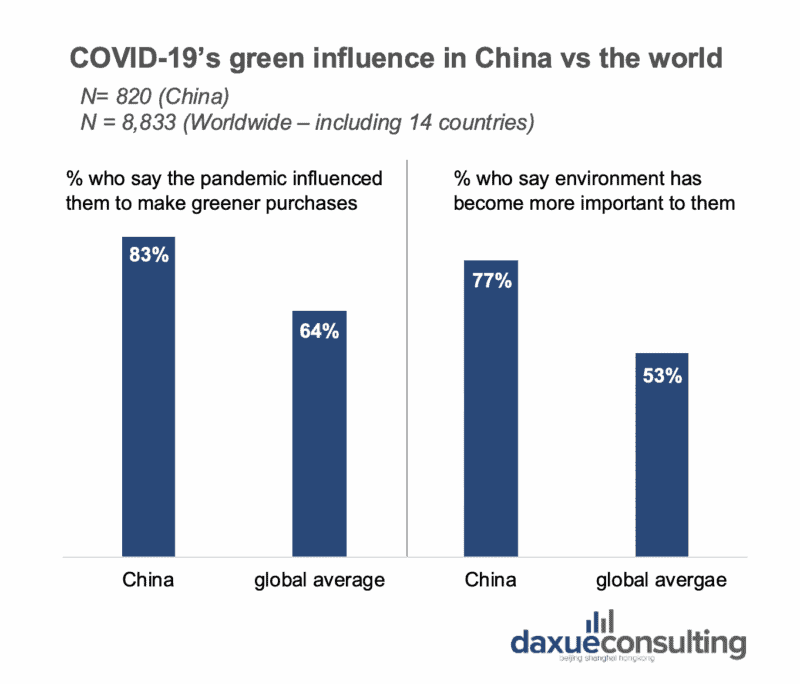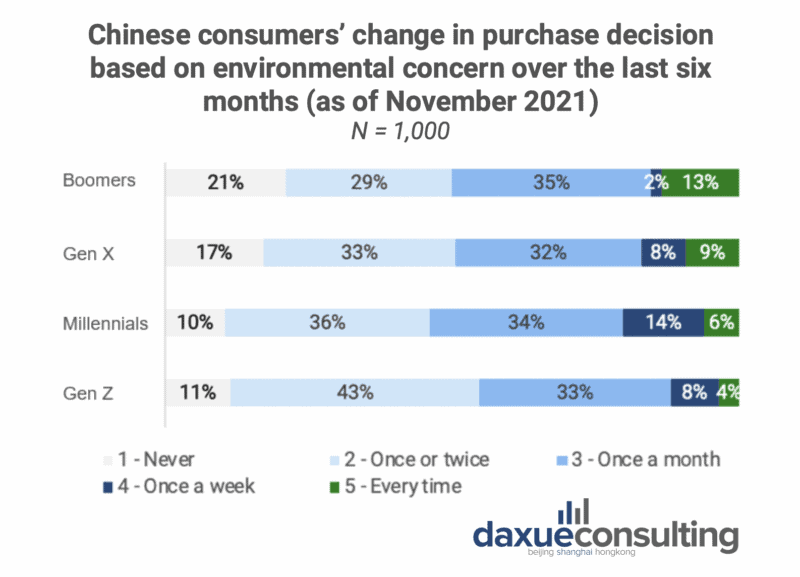Green consumption refers to consumers’ preference towards environmental-friendly products. The awareness of sustainability in China and green consumption has been a growing trend in pre-pandemic times and Chinese consumers have been increasingly motivated to choose eco-friendly and social-friendly products for the sake of protecting the environment. This has been proven by a number of recent surveys showing that COVID-19 has accelerated the transition to sustainable consumption in China.
According to Accenture, the pandemic had a stronger influence on Chinese consumers than average globally. More Chinese people are making an extra effort in sustainable purchases in the future and claim that the environment has, as a result of the pandemic, become more crucial to them. Likewise, CBN Data observed that companies focusing on environmental protection tend to be favored by consumers.

We recently conducted a survey on Chinese perception and consumer behavior towards sustainability and found that the younger generations in general display a higher interest in the “green” trend. Namely, 90% of Gen Z and Millennials have altered their purchase decision at least once in the last six months due to increased environmental concern, compared to only 83% of Gen X and 79% of Baby Boomers.

Another indicator for the trend is the growing expectation and demand of Chinese consumers for businesses and the government to play a larger role in promoting sustainable and ethical consumption, by making these products more accessible and easier to purchase. KFC in China’s promotion for sustainability, for example, is received with great enthusiasm by Chinese consumers. The franchise in China includes vegan options in their menu, initiated a plastic reduction project, and launched an interactive green rewards program.
How can companies navigate the changing consumer behavior?
Brands cannot use environmental friendliness as their only unique selling point (USP), as Chinese consumers expect the green image as given by brands. On the other hand, there is a significant gap between green consumption attitude and actual purchase. Unfavorable conditions can quickly undermine eco-friendly attitudes. For instance, 33% of respondents were intent on buying organic food but only 1% follow through with the purchase. This is due to price, quality, and convenience remaining more important than sustainability in Chinese consumers’ decision-making process. Therefore, brands must balance these other attributes with sustainability to effectively attract Chinese consumers.
Further approaches for brands to bridge the gap between green attitude and actual purchase:
- Reframe communication by highlighting positive impact on the environment with the consumption instead of the frustrating negative impact
- Educate consumers better on sustainability and individual’s power to make an impact
- Offer easier access to sustainable products
- Define identity as well as company vision in relation to the environment and disseminate with consumers
- Find ways to incorporate older generations who have not embraced the green mindset as extensively
Our recent survey on Chinese perception towards sustainability also shows that consumers from tier 1 and 2 cities along with those with higher income had a higher tendency to adapt their purchase decision based on environmental concerns. This is an indicator for better educational background and availability as well as easy access leading to more green purchases.
Building trust is a key to green consumption in China
During the pandemic, 89% of the respondents said they turned to brands and products that they truly believe were sustainable. How can brands establish such trust?
- Collaborate in forming sustainability indices within industries
- Promote green product certification
- Establish product guarantees
- Increase transparency and traceability
- Explore new business models such as innovative traceability systems
Smaller brands are at an advantage to review their supply chains and adapt to them accordingly, while bigger brands should leverage their weight within the industry to drive forward sustainability indices and certifications. With the support of the government, the General Administration of Customs of P.R. China (GACC) released a new food import law in April 2021, which includes improving food safety and traceability. On January 21, 2022, the National Development and Reform Commission (NDRC) published the implementation plan for promoting green consumption in China (促进绿色消费实施方案) which aims to improve the green consumption guarantee system and promote green consumption technology and service support.
Key takeaways
- COVID-19 has accelerated green consumption in China and impacted their desire for environmental protection more than the global average, predominantly due to health and safety reasons
- However, characteristics like price, quality, and convenience are still prioritized over sustainability in Chinese consumers’ decision-making process
- Brands should increase their effort to leverage this opportunity accordingly:
- Target gap between green intention and actual purchase
- Underline positive environmental impact by purchasing the specific product
- Increase accessibility of sustainable products
- Balance environmental friendliness with price, quality and convenience
- Instill trust towards brand being genuinely eco-friendly
Author: Lucia Toth





